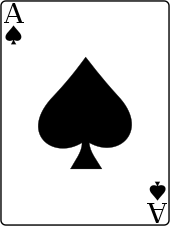Spades (card game)
| Spades | |
|
Ace of Spades
|
|
| Origin | Fort Lauderdale, Florida |
|---|---|
| Alternative names | Call Bridge |
| Type | Trick-taking |
| Players | 4 (standard) |
| Skills required | Card counting, Tactics |
| Age range | All |
| Cards | 52-54 |
| Deck | French |
| Play | Clockwise |
| Card rank (highest to lowest) | A K Q J 10 9 8 7 6 5 4 3 2 |
| Playing time | 90 min. |
| Random chance | Moderate |
| Related games | |
| Bid Whist, Contract Bridge, Tarneeb, Oh Hell | |
Spades is a trick-taking card game devised in the United States in the 1930s. It can be played as either a partnership or solo/"cutthroat" game. The object is to take at least the number of tricks (also known as "books") that were bid before play of the hand began. Spades is a descendant of the Whist family of card games, which also includes Bridge, Hearts, and Oh Hell. Its major difference as compared to other Whist variants is that, instead of trump being decided by the highest bidder or at random, the Spade suit is always trumps, hence the name.
Spades was devised in the United States in the late 1930s and became popular in the 1940s. It is unclear which game it is most directly descended from, but it is known that Spades is a member of the Whist family and is a simplification of Contract Bridge such that a skilled Spades player can learn Bridge relatively quickly (the major additional rules being dynamic trump, the auction, dummy play, and rubber scoring).
The game's rise to popularity in the U.S. came during World War II, when it was introduced by soldiers from its birthplace in Cincinnati, Ohio to various military stations around the world. The game's popularity in the armed forces stems from its simplicity compared to Bridge and Euchre and the fact that it can be more easily interrupted than Poker, all of which were also popular military card games. After the war, veterans brought the game back home to the U.S., where due to the GI Bill it spread to and became popular among college students as well as in home games. It also remained widely popular in countries in which U.S. troops were stationed, both in WWII and later deployments.
The first dealer is chosen by a draw for "first spade" or "high card", and thereafter the deal passes to the dealer's left after each hand. The dealer shuffles, and the player to the right is given the opportunity to "cut" the cards to prevent the dealer stacking the deck. The entire deck is then dealt face-down one card at a time in clockwise order (with four players, each player should receive 13 cards). The players then pick up their cards, verify the correct count of the cards, and arrange them as desired (the most common arrangement is by suit, then rank).
...
Wikipedia

